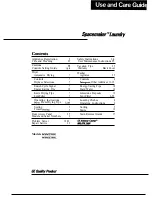
7
Drying Vegetables
Vegetables dry much faster than fruits. At the end of the drying period, moisture loss is rapid. As a result, vegetables need to be checked
often towards the end of the drying time to prevent overdrying. Food turns brown when it is overdried. When drying smaller vegetables, such
as peas or carrots, it is recommended that you use a mesh screen.* A mesh screen will help prevent smaller foods from falling through the
grates in the tray during dehydration.
Selection and Preparation
Wash vegetables to remove dirt and debris. Trim vegetables to remove fibrous or woody portions or bruised and decayed areas, peel, and
slice using the preparation information found on the Vegetable Drying Guide. Slice or cut vegetables into pieces that are uniform in size. See
guide for pretreatment information on specific vegetables.
Pretreatment
The process of blanching involves subjecting vegetables to a high enough temperature to deactivate the enzymes. Blanching is necessary to
stop the naturally occurring enzymes from causing loss of color and flavor during drying and storage. Blanching also relaxes the tissue walls
so moisture can more readily escape during drying and enter during rehydrating. Blanching can be done in water or steam. Water blanching
causes a greater loss of nutrients but is faster than steam blanching and achieves a more even heat penetration.
Steam blanching:
Fill a deep pot with water and bring to a boil. Place vegetables loosely in a basket or colander that will allow steam
to freely circulate around the vegetables. Do not fill basket or colander with more than a 2½-inch layer of vegetables. Position the basket
or colander in the pot, making sure it does not contact the boiling water. Cover with a close fitting lid. Steam for the time indicated in the
Vegetable Drying Guide.
Water blanching:
Fill a large pot ⅔ full with water. Cover and bring to a boil. Place vegetables loosely in a basket or colander and submerge
in the boiling water. Cover and blanch for the time indicated in the Vegetable Drying Guide. Water should return to a boil in less than 1
minute. If not, too many vegetables were added to the basket; reduce the amount of vegetables added for the next batch. Water blanch for
the time indicated in the Vegetable Drying Guide.
Immediately after steam or water blanching, dip the vegetables in cold water to quickly cool them. Drain the vegetables and arrange them in
a single layer on the dehydrator trays. Refer to the Vegetable Drying Guide for drying times.
Determining Dryness
Refer to the Vegetable Drying Guide and begin checking the vegetables at the beginning of the average drying time range. Remove a few
pieces of vegetables from each dehydrator tray and allow to cool to room temperature. Test for dryness by breaking the pieces in half. Most
vegetables will be crisp when appropriately dried and will break easily. If vegetables do not break easily, additional drying time is needed. If
vegetables seem to have a lot of moisture remaining, recheck every 1 to 2 hours. If vegetables appear to be almost done, check again in 30
minutes. Always check vegetables from each tray. Follow “Packaging and Storing Dried Food” information on page 8.
Vegetable Drying Guide
Drying times are highly variable and dependant on the type and amount of food, thickness, evenness of food pieces, humidity, air temperature, personal
preference, and the age of the plant at the time of harvesting.
Vegetable
Preparation
Pretreatment (blanching)
Average Drying Time
Asparagus
Cut into 1˝ pieces.
water 3½–4½ minutes
steam 4–5 minutes
5–7 hours
Beans, green/wax
Remove ends and strings. Cut into 1˝ pieces.
water 2 minutes
steam 2–2½ minutes
5–10 hours
Beets
Cook until tender. Cool and peel. Cut into
shoestring strips ⅛˝ thick.
None—Already cooked
3–6 hours
Broccoli
Cut into serving pieces.
water 2 minutes
steam 3–3½ minutes
3–7 hours
Carrots
Peel and cut off ends. Cut into ⅛˝ to ¼˝ slices.
water 3 minutes
steam 3–3½ minutes
3–9 hours
Cauliflower
Cut into serving pieces.
water 3–4 minutes
steam 4–5 minutes
4–7 hours
Celery
Trim ends. Cut into ¼˝ slices.
water 2 minutes
steam 2 minutes
2–4 hours
Corn, cut
Husk and remove silk. Blanch. Cut corn from cob.
water 1½ minutes
steam 2–2½ minutes
6–10 hours
Mushrooms
Wash and slice ⅜˝ thick.
None
2–6 hours
* Nonstick mesh screens are sold separately (see page 10).




























